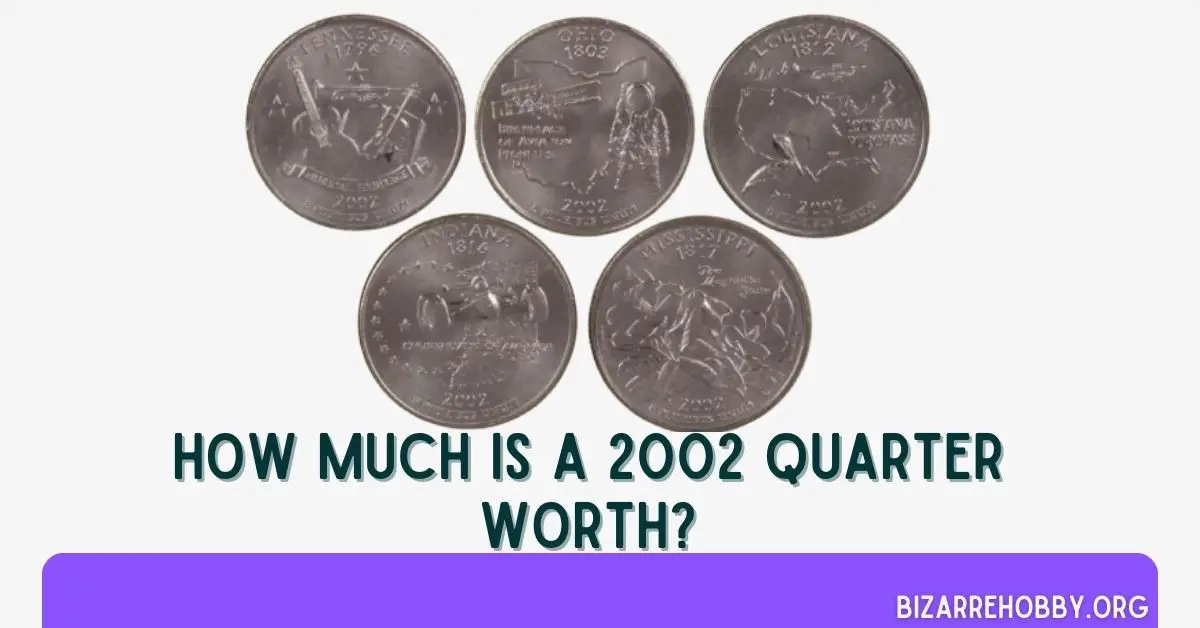Are you thinking of adding any of the five state quarters minted in 2002 to your collection?
This guide is crafted just for you!
We’ll dive into everything you need to know about the value of 2002 quarters.
In 2002, the United States Mint released five state quarters: Tennessee, Mississippi, Ohio, Louisiana, and Indiana, all under the Commemorative Coins Act.
These quarters are relatively modern, so they remain in circulation and are widely available in the market, making them an affordable addition for many collectors.
Adding quarters from 2002 to your Washington quarter collection is a fantastic way to preserve their historical and sentimental significance.
So, without further delay, let’s explore: How much is a 2002 quarter really worth?
Value Chart for 2002 Tennessee Quarter
| Mint Mark | Good | Fine | Extremely Fine | Uncirculated |
|---|---|---|---|---|
| 2002-P Tennessee Quarter | $0.30 | $0.30 | $0.30 | $3.38 |
| 2002-D Tennessee Quarter | $0.30 | $0.30 | $0.30 | $3.38 |
| 2002- S Tennessee Silver Proof Quarter | – | – | – | $15 |
| 2002-S Tennessee Clad Proof Quarter | – | – | – | – |
Value Chart for 2002 Ohio Quarter
| Mint Mark | Good | Fine | Extremely Fine | Uncirculated |
|---|---|---|---|---|
| 2002-P Ohio Quarter | $0.30 | $0.30 | $0.30 | $1.76 |
| 2002-D Ohio Quarter | $0.30 | $0.30 | $0.30 | $1.76 |
| 2002- S Ohio Silver Proof Quarter | – | – | – | $15 |
| 2002-S Ohio Clad Proof Quarter | – | – | – | – |
Value Chart for 2002 Louisiana Quarter
| Mint Mark | Good | Fine | Extremely Fine | Uncirculated |
|---|---|---|---|---|
| 2002-P Louisiana Quarter | $0.30 | $0.30 | $0.30 | $1.76 |
| 2002-D Louisiana Quarter | $0.30 | $0.30 | $0.30 | $1.76 |
| 2002- S Louisiana Silver Proof Quarter | – | – | – | $15 |
| 2002-S Louisiana Clad Proof Quarter | – | – | – | – |
Value Chart for 2002 Indiana Quarter
| Mint Mark | Good | Fine | Extremely Fine | Uncirculated |
|---|---|---|---|---|
| 2002-P Indiana Quarter | $0.30 | $0.30 | $0.30 | $1.76 |
| 2002-D Indiana Quarter | $0.30 | $0.30 | $0.30 | $1.76 |
| 2002- S Indiana Silver Proof Quarter | – | – | – | $15 |
| 2002-S Indiana Clad Proof Quarter | – | – | – | – |
Value Chart for 2002 Mississippi Quarter
| Mint Mark | Good | Fine | Extremely Fine | Uncirculated |
|---|---|---|---|---|
| 2002-P Mississippi Quarter | $0.30 | $0.30 | $0.30 | $1.76 |
| 2002-D Mississippi Quarter | $0.30 | $0.30 | $0.30 | $1.76 |
| 2002- S Mississippi Silver Proof Quarter | – | – | – | $15 |
| 2002-S Mississippi Clad Proof Quarter | – | – | – | – |
History of 2002 Quarter
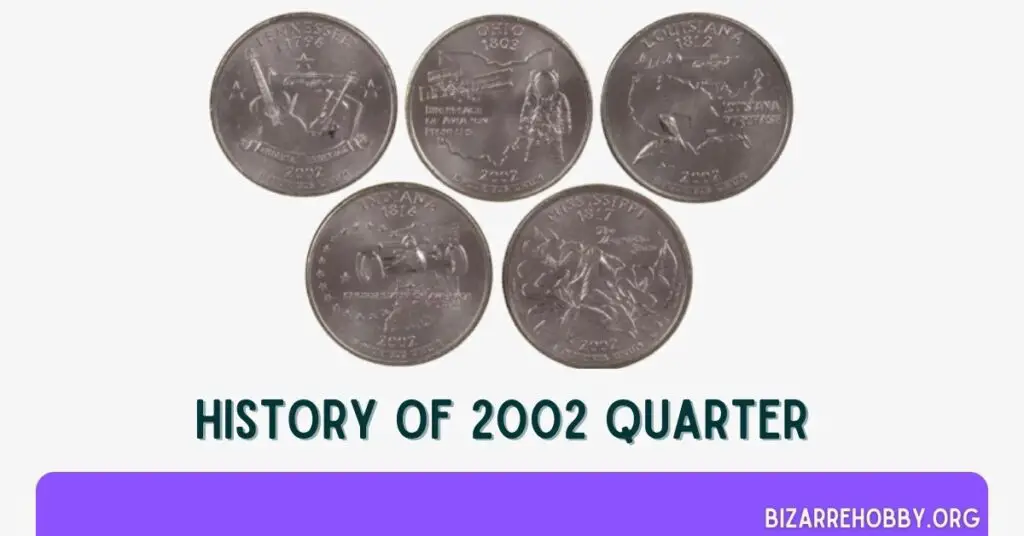
The 2002 quarters belong to the distinguished Washington quarter series, which began its journey in 1932 and remains a staple in everyday transactions.
For decades, from 1932 to 1998, the Mint produced a consistent design for the quarter, which was circulated across the nation. These classic Washington quarters prominently display a left-facing image of President George Washington on the front, with a majestic eagle gracing the back.
However, 1999 marked a pivotal change when the Mint began showcasing state symbols on the reverse side. This transformation was the brainchild of Philip Diehl, the Mint Director in 1995, who suggested that Congress introduce state-themed commemorative coins.
Congress greenlit the idea, leading to the enactment of the United States Commemorative Coins Act in 1996, which President Bill Clinton later signed into law.
This Act mandated the Mint to evaluate whether state-themed coins would be both financially viable and popular among the public. With positive findings, the 50 States Commemorative Coin Program Act was passed in 1997, officially launching the program.
The initiative was designed to pay tribute to each of the 50 states by releasing quarters that feature state-specific emblems on the reverse. The plan was to release five new state quarters each year, following the chronological order in which the states joined the Union.
The Act also gave the Treasury Secretary the authority to decide on the placement of essential inscriptions such as “UNITED STATES OF AMERICA,” “IN GOD WE TRUST,” and “LIBERTY.”
To allow more room for the intricate designs on the reverse, these elements, including “THE UNITED STATES OF AMERICA” and “QUARTER DOLLAR,” were repositioned to the obverse. Consequently, Washington’s portrait was slightly reduced in size to accommodate the added text and features. The Treasury collaborated closely with state governors to finalize the reverse designs of the coins.
In 2002, the commemorative state quarters honored Ohio, Louisiana, Tennessee, Mississippi, and Indiana.
Designs of the 2002 Quarters
In this segment, we explore distinguishing features and designs of the five state quarters issued in 2002. Knowing these details can help you determine if any 2002 quarters in your possession might be of higher value.
Obverse Design of 2002 Quarters
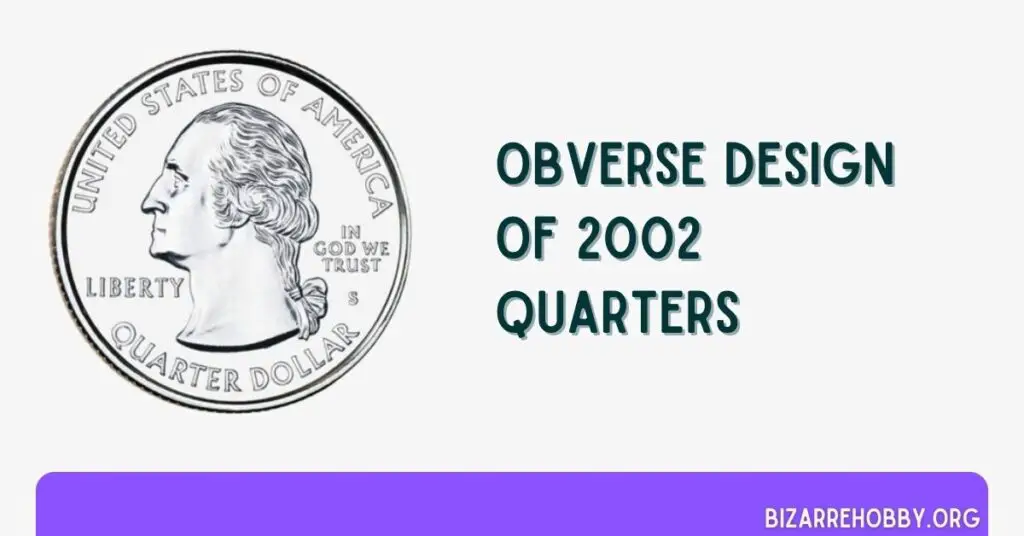
The Tennessee quarter was the inaugural release in the 2002 Washington quarter series. The front of the coin showcases a left-facing portrait of President George Washington.
Encircling the top inner edge is the inscription “UNITED STATES OF AMERICA,” while the coin’s value, “QUARTER DOLLAR,” is placed at the bottom.
“LIBERTY” is boldly inscribed on the left, while the motto “IN GOD WE TRUST” is located on the right, just behind Washington’s image.
The same front design is shared by the Ohio, Indiana, Louisiana, and Mississippi quarters.
Reverse Design of 2002 Quarters
Each of the five 2002 quarters features a distinct and meaningful design on the back.
Reverse Design of Tennessee 2002 Quarters
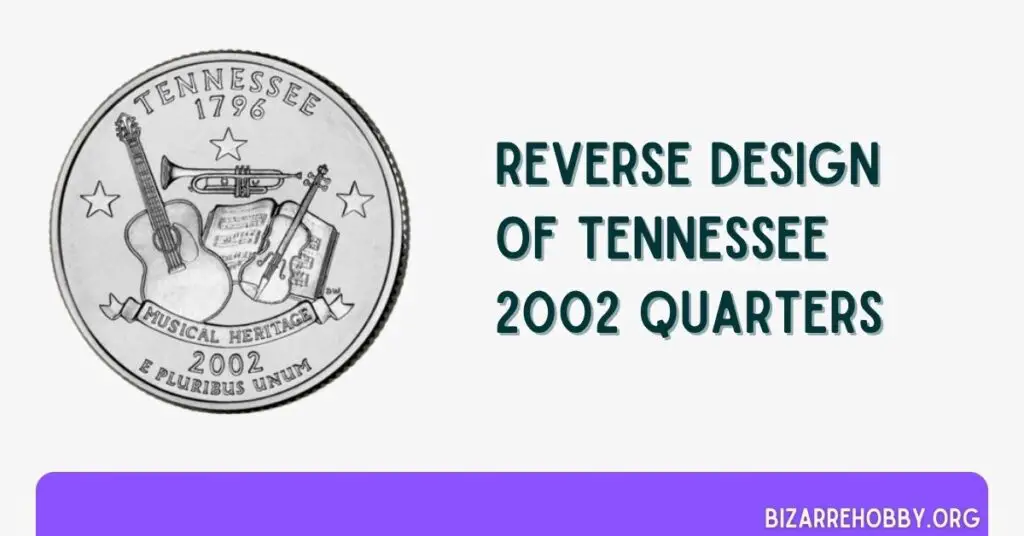
The Tennessee quarter pays homage to the state’s rich musical legacy. The back design includes an array of musical instruments, such as a fiddle, trumpet, and guitar.
The fiddle represents the Appalachian music of East Tennessee, the trumpet symbolizes the blues of West Tennessee, and the guitar nods to Nashville, the heart of country music.
Additionally, three stars are featured, representing the state’s three regions—east, west, and central—and their associated musical traditions.
The phrase “Musical Heritage” is inscribed below the instruments, with the state’s name at the top, followed by “1796,” the year Tennessee was admitted to the Union.
At the bottom, you’ll find the year “2002,” along with the motto “E PLURIBUS UNUM,” meaning “Out of many, one.”
Reverse Design of Ohio 2002 Quarters
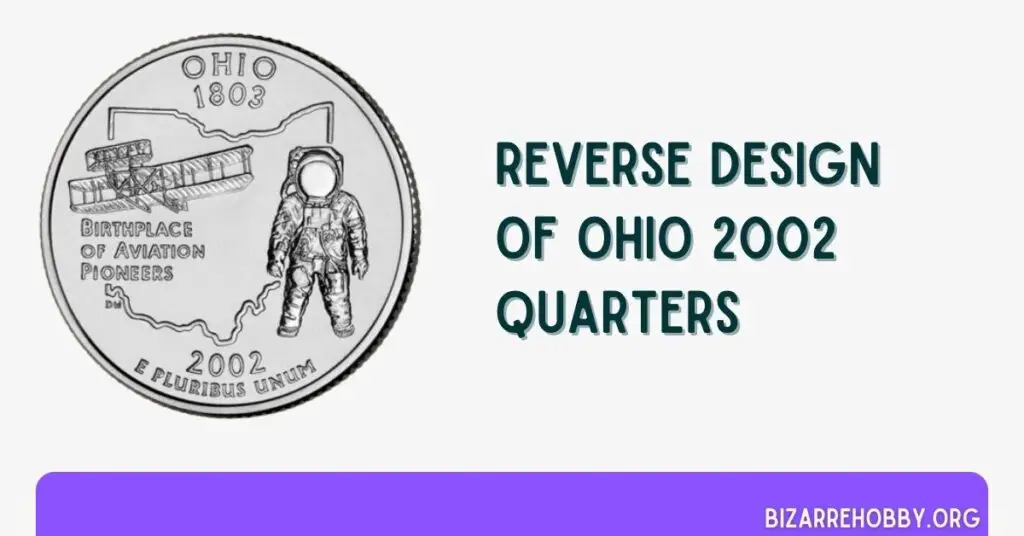
The Ohio quarter, the second in the series, highlights the state’s significant contributions to the field of aviation.
Ohio is the birthplace of the Wright brothers, Wilbur and Orville, who revolutionized human flight, as well as astronauts John Glenn and Neil Armstrong.
The back design features the outline of Ohio, overlaid with the image of an astronaut and an early aircraft.
The phrase “BIRTHPLACE OF AVIATION PIONEERS” is prominently displayed on the left side.
Reverse Design of Louisiana 2002 Quarters
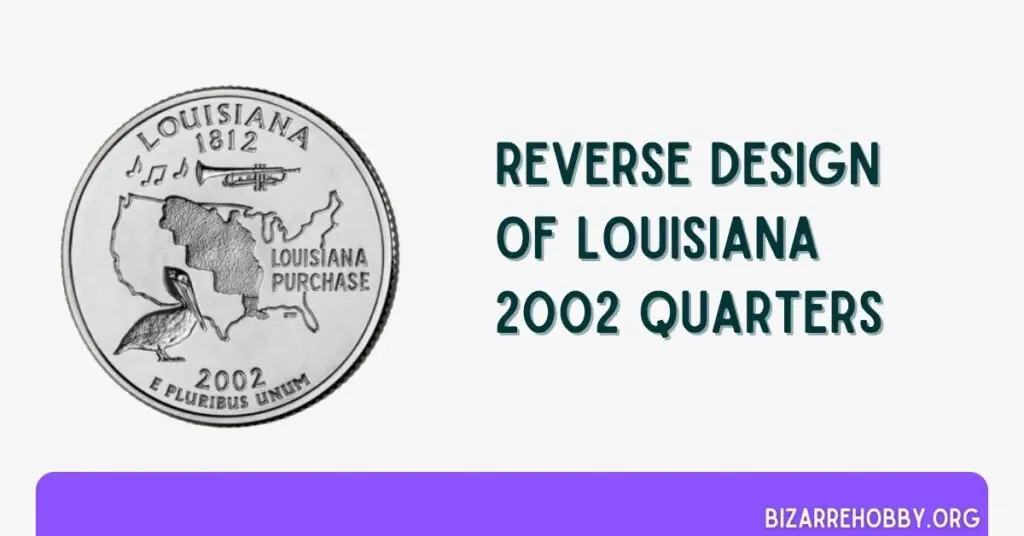
The third coin in the series is the Louisiana quarter. The back design highlights the historic Louisiana Purchase territory, alongside a pelican (the state bird), a trumpet, and musical notes.
In 1803, President Thomas Jefferson negotiated the Louisiana Purchase with Napoleon Bonaparte, acquiring the territory for $15 million, which added thirteen states to the Union and greatly expanded the size of the United States.
The words “LOUISIANA PURCHASE” are featured on the outline of the territory.
The trumpet symbolizes Louisiana’s deep-rooted connection to jazz music, which originated in New Orleans and grew to become a global phenomenon.
Reverse Design of Indiana 2002 Quarters
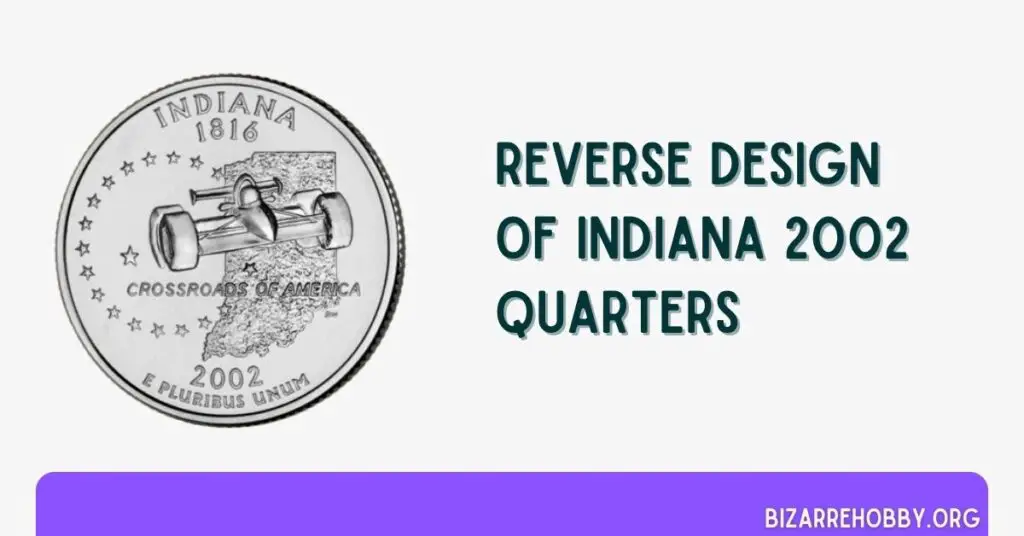
The Indiana quarter, the fourth in the series, celebrates the state’s rich automotive racing heritage, particularly the iconic Indianapolis 500.
The back design displays the outline of Indiana, along with a depiction of a race car and the phrase “CROSSROADS OF AMERICA.”
Nineteen stars are also included, representing Indiana’s position as the 19th state to join the Union.
Reverse Design of Mississippi 2002 Quarters
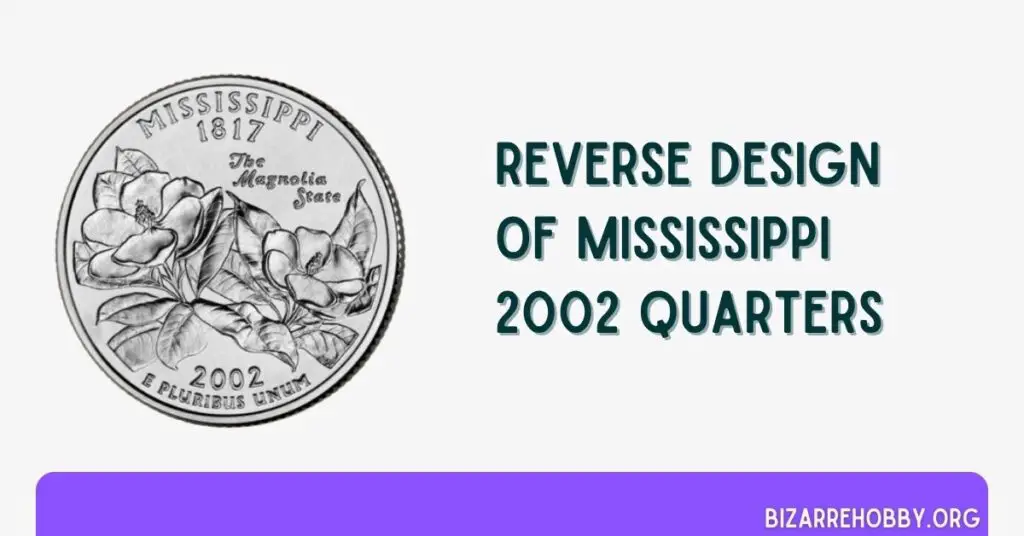
The final coin in the series is the Mississippi quarter, which showcases the state’s natural beauty.
The back design features a detailed depiction of the Magnolia grandiflora, a flower known for its large, striking petals. Mississippi, which officially adopted the Magnolia as its state flower in 1952, is often referred to as the Magnolia State.
The phrase “MAGNOLIA STATE” appears alongside the flower on the back.
Technical Specifications of 2002 Quarters
All five 2002 quarters are made from an alloy consisting of 75% copper and 25% nickel.
These coins have a reeded edge, a diameter of 24.30 millimeters, and a weight of 5.67 grams.
They were minted at the Philadelphia, Denver, and San Francisco mints, with the respective mint marks (“P,” “D,” and “S”) appearing on the front of the coin near Washington’s pigtail.
The front of the coin also bears the initials “J F,” representing John Flanagan, the original designer of the Washington quarter. On the back, you’ll find the initials “D W,” which stand for Donna Waters, the designer responsible for the reverse design.
How to Grade a 2002 Quarter?
When it comes to the value of 2002 quarters, most of them are generally worth no more than their face value, especially those that have seen circulation. These coins don’t typically offer significant profit potential unless they are in exceptional, mint condition.
For collectors, finding a pristine 2002 quarter is like discovering a hidden gem. These coins are rare, and their value is notably higher due to their flawless appearance. To spot one, look for a consistent, unbroken luster across the coin’s surface, and pay close attention to the sharpness of the mint mark and date.
Coins that are graded at MS67 and higher, often referred to as gem-quality, should be free from any imperfections, including contact marks, hairlines, or dings. Achieving such a grade indicates the coin is nearly perfect, which significantly increases its value.
| Grade Number | Grade |
|---|---|
| 1 | Basal State-1 |
| 2 | Fair |
| 3 | Very Fair |
| 4, 5, 6 | Good |
| 7, 8, 10 | Very Good |
| 12, 15 | Fine |
| 20, 30 | Very Fine |
| 40 | Extremely Fine |
| 50 | About Uncirculated |
| 60 | Mint State |
| 65 | Mint State |
| 70 | Mint State |
For a more detailed understanding of how to grade your coins and determine their worth, don’t miss our grading guide. Knowing your coin’s exact grade is essential for accurately assessing its market value.
2002 Quarter Value Guides
So, are your 2002 quarters valuable? The short answer is that most 2002 quarters are only worth their face value, especially since they are relatively recent. However, as time goes on and these coins become rarer in mint condition, their value could increase significantly.
When evaluating the value of your 2002 quarters, factors like mintage, mint mark, and possible minting errors play a crucial role.
There are four main types of 2002 state quarters that we’ll explore further:
- 2002-P Quarters
- 2002-D Quarters
- 2002-S Proof Clad Quarters
- 2002-S Proof Silver Quarters
Let’s dive into the details of each, focusing on their potential value.
2002 Quarter (Regular Strike) Value
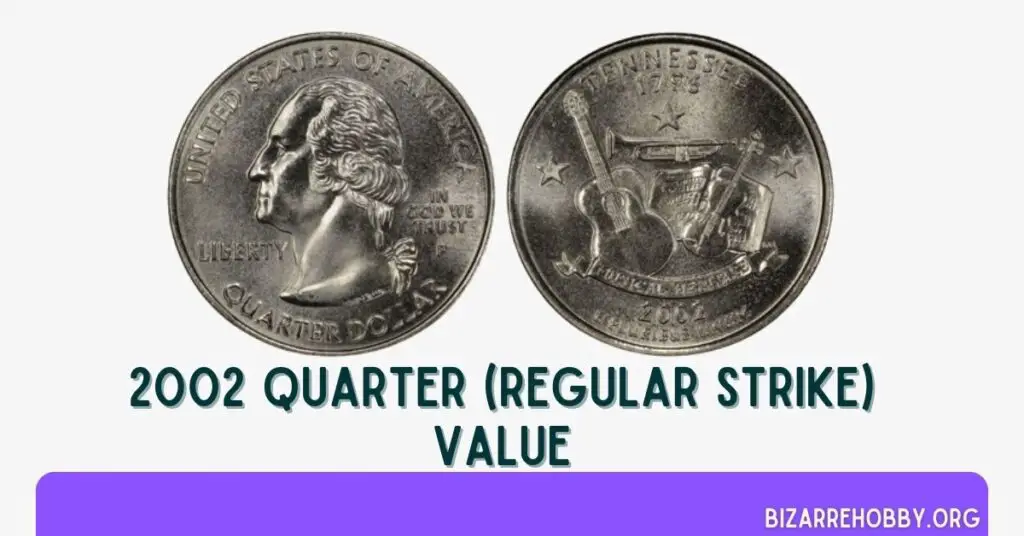
For circulated 2002 quarters from Tennessee, Ohio, Louisiana, Indiana, and Mississippi, you’re looking at a value close to their face value. Whether you’re buying or selling, expect these coins to be worth around $0.30 to $0.40 if they’ve been in circulation.
The U.S. Mint produced millions of these coins, releasing most into circulation. This high production volume means that finding these coins in circulation is relatively easy, making them accessible to collectors at an affordable price.
However, the story changes for 2002 quarters in pristine, mint condition. The value of these coins can vary significantly depending on their mint mark, which is linked to the mintage.
For instance:
- Tennessee 2002-P Quarters: In gem condition, graded MS69 or higher, these can fetch up to $225. Meanwhile, a Tennessee 2002-D quarter of the same grade could bring in as much as $425.
- Ohio 2002-P Quarters: These can be worth up to $240 for an uncirculated regular strike. With approximately 414,832,000 Ohio state quarters struck at the Denver mint, finding uncirculated examples is rare, and Ohio 2002-D quarters in MS69 or higher are extremely rare, fetching up to $4,000.
- Louisiana 2002-P Quarters: Produced in large numbers at the Philadelphia Mint, these are scarce in uncirculated condition. An MS69 specimen can be worth up to $325. On the other hand, the Denver mint produced even more, and MS69 Louisiana quarters are more common, valued at around $60.
- Indiana 2002 Quarters: An uncirculated 2002-P Indiana quarter can fetch at least $360, while mint examples from Denver are even rarer and can command as much as $4,500.
- Mississippi 2002-P Quarters: Mint condition coins can sell for up to $1,250, while those from Denver are common and valued at around $90 in mint state.
2002 Silver and Clad Quarter Value
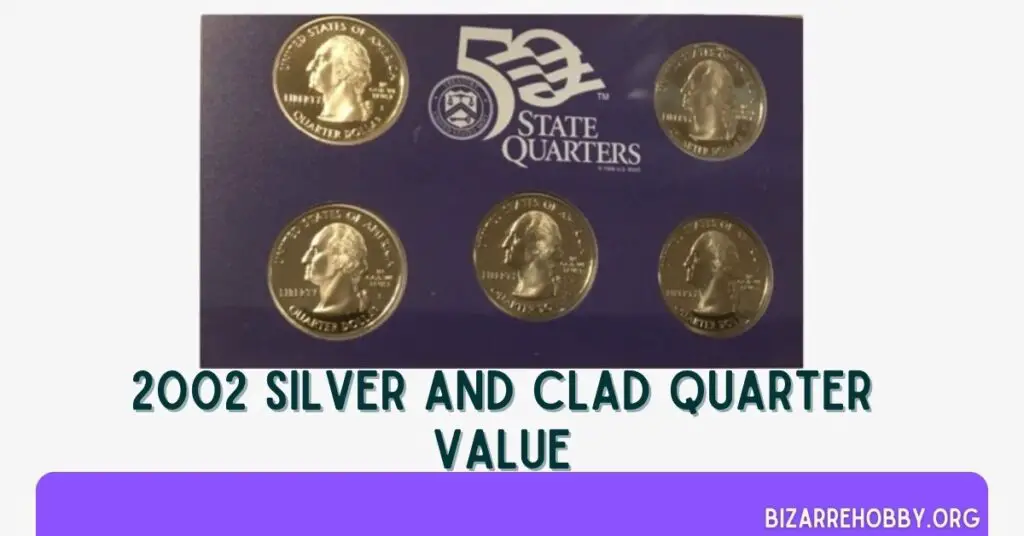
In addition to the regular strike quarters, the San Francisco Mint produced proof sets for collectors, available in both silver and clad versions.
Proof 2002 state quarters are generally affordable due to their relatively high mintage, making them accessible to most collectors.
- Tennessee 2002-S Clad Quarters: These can sell for up to $22.50 for cameo pieces graded PF70, and around $50 for ultra-cameo examples. Silver versions are slightly more valuable, with cameo pieces fetching up to $38 and ultra-cameo examples valued at about $80.
- Ohio 2002-S Quarters: Clad versions can bring in up to $22.50, with ultra-cameo pieces selling for $40. Silver proof quarters can fetch up to $30.
- Louisiana 2002-S Quarters: Clad versions are worth between $25 and $55, while silver examples range from $35 to $55.
- Indiana 2002-S Quarters: Clad versions sell for as much as $22.50, with silver pieces priced between $40 and $100, depending on the cameo grade.
- Mississippi 2002-S Quarters: Clad versions are valued between $22.50 and $45, while silver pieces trade between $35 and $50 for cameo and ultra-cameo specimens.
Rare 2002 Quarter Errors List
Despite the large-scale production of 2002 quarters, only a handful of error coins have been identified. The majority of these coins were minted using high-quality dies, which significantly reduced the occurrence of minting flaws. However, a few errors do exist, and some are valuable.
Here are the key 2002 quarter errors to watch out for:
2002 Doubled Die Quarter Error
One of the most sought-after errors in 2002 quarters is the doubled die variety. These errors can be quite valuable, with some coins fetching up to $150, especially if they’re in excellent condition.
This error occurs when the die strikes the blank planchet more than once but slightly misaligned. This causes a noticeable doubling on elements of the coin, particularly on the inscriptions like “IN GOD WE TRUST,” “LIBERTY,” and “QUARTER DOLLAR.”
2002 Strike Through Quarter Error
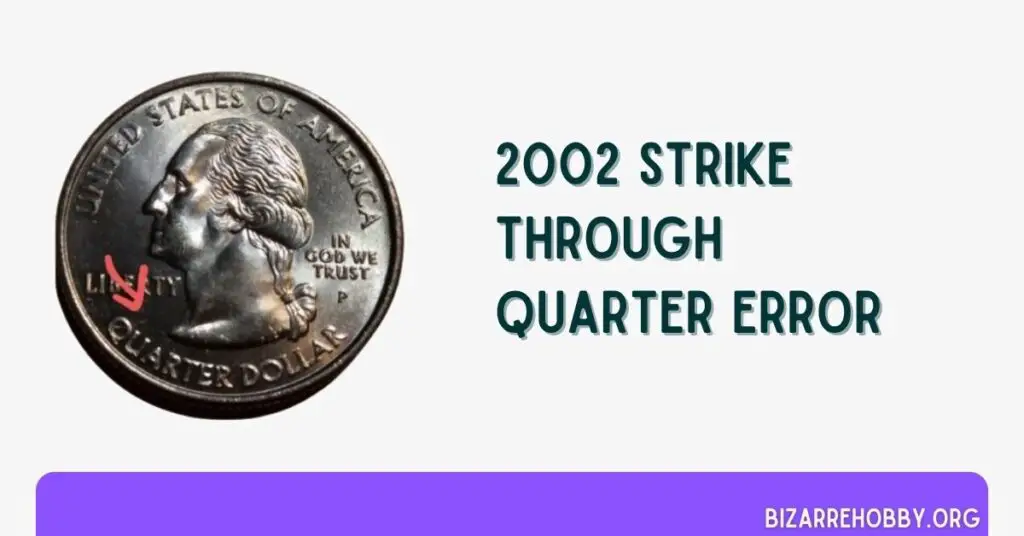
Another error to keep an eye out for is the strike-through error, often referred to as a strike-thru. This happens when a foreign object, such as grease, dust, or other debris, comes between the die and the planchet during the minting process.
For instance, on some 2002 quarters, the “T” in “TRUST” may be partially or entirely missing due to an obstruction, commonly referred to as a strike-thru grease error. These 2002 error quarter coins can be worth around $50.
Where To Sell Your 2002 Quarter?
Now that you have an idea of what your 2002 quarters might be worth, you may be wondering where to sell them. The online marketplace offers several platforms to easily sell your coins. To help you navigate, we’ve compiled a list of the best sites, along with their pros and cons.
FAQs on 2002 Quarter Value
Is it worth collecting 2002 quarters?
If you’re thinking long-term, collecting 2002 quarters might be a good investment. While they’re generally only worth face value today, their value could increase as they age. Older coins tend to be worth more, so holding onto 2002 quarters could pay off down the road.
Are 2002 quarters rare?
In general, 2002 quarters aren’t considered rare, particularly those that have been circulated. The Mint produced millions of these coins, and they were widely distributed. However, coins in gem-quality condition are rare and can command a higher price.
Are 2002 quarters with an “S” mint mark silver?
Yes, some 2002 quarters with the “S” mint mark are made of silver, while others are clad coins composed of a copper-nickel blend with a copper core. The silver quarters are typically shinier and more lustrous than their clad counterparts.
Final Thoughts
While 2002 quarters might not hold significant value for most collectors today, their potential lies in the future.
As these coins age and gem-quality examples become increasingly rare, their worth could rise, making them a worthwhile addition to your collection. Whether you’re intrigued by error coins or simply enjoy the thrill of the hunt, 2002 quarters offer a fascinating glimpse into modern minting and the enduring allure of U.S. coinage.
If you have a favorite quarter from this series, we’d love to hear about it—share your thoughts with us!
